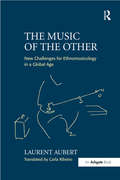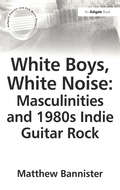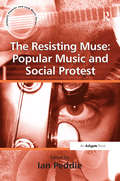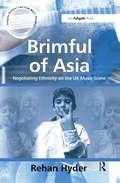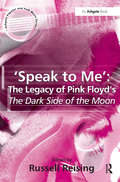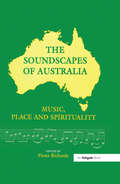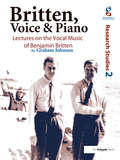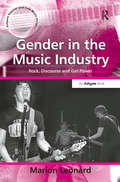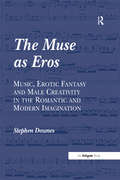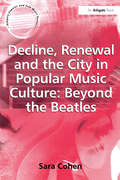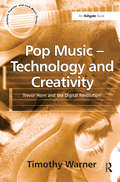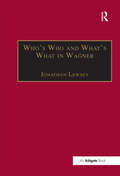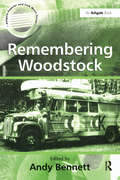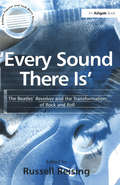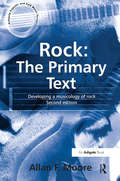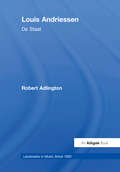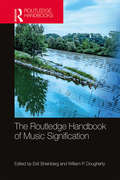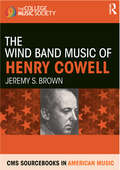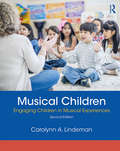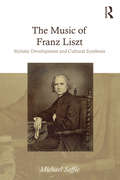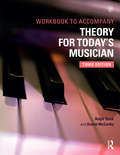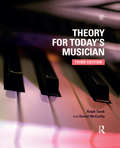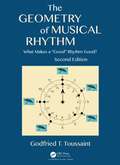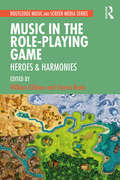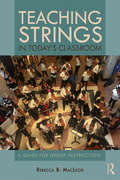- Table View
- List View
The Music of the Other: New Challenges for Ethnomusicology in a Global Age
by Laurent AubertWe are surrounded by new musical encounters today as never before, and the experience of musics from elsewhere is progressively affecting all arenas of the human conscience. Yet why is it that Western listeners expect a certain cultural and ethnic 'authenticity' or 'otherness' from visiting artists in world music, while contemporary musicians in Western music are no longer bound by such restraints? Should we feel uncomfortable when sacred rites from Asia or Africa are remade for Westerners as musical entertainment? As these thorny questions suggest, the great flood of world musics and of their agents into our most immediate cultural environment is not a simple matter of expanding global musical exchange. Instead, complex processes are at work involving the growth of intercontinental tourism, the development of new technologies of communication and our perceptions both of ourselves and of the new musical others now around us. Elegantly tracing the dimensions of these new musical encounters, Laurent Aubert considers the impact of world musics on our values, our habits and our cultural practices. His discussions of key questions about our contemporary music culture widen conventional ethnomusicological perspectives to consider not only the nature of Western society as a 'global village' but also the impact of current Western demands on the future of world musics and their practitioners.
White Boys, White Noise: Masculinities And 1980s Indie Guitar Rock (Ashgate Popular and Folk Music Series)
by Matthew BannisterTo what extent do indie masculinities challenge the historical construction of rock music as patriarchal? This key question is addressed by Matthew Bannister, involving an in-depth examination of indie guitar rock in the 1980s as the culturally and historically specific production of white men. Through textual analysis of musical and critical discourses, Bannister provides the first book-length study of masculinity and ethnicity within the context of indie guitar music within US, UK and New Zealand 'scenes'. Bannister argues that past theorisations of (rock) masculinities have tended to set up varieties of working-class deviance and physical machismo as 'straw men', oversimplifying masculinities as 'men behaving badly'. Such approaches disavow the ways that masculine power is articulated in culture not only through representation but also intellectual and theoretical discourse. By re-situating indie in a historical/cultural context of art rock, he shows how masculine power can be rearticulated through high, avant-garde, bohemian culture and aesthetic theory: canonism, negation (Adorno), passivity, voyeurism and camp (Andy Warhol and the Velvet Underground), and primitivism and infantilism (Lester Bangs, Simon Reynolds). In a related vein, he also assesses the impact of Freud on cultural theory, arguing that reversing binary conceptions of gender by associating masculinities with an essentialised passive femininity perpetuates patriarchal dualism. Drawing on his own experience as an indie musician, Bannister surveys a range of indie artists, including The Smiths, The Jesus and Mary Chain, My Bloody Valentine and The Go-Betweens; from the US, R.E.M., The Replacements, Dinosaur Jr, Hüsker Dü, Nirvana and hardcore; and from NZ, Flying Nun acts, including The Chills, The Clean, the Verlaines, Chris Knox, Bailter Space, and The Bats, demonstrating broad continuities between these apparently disparate scenes, in terms of gender, aesthetic theory and approaches to popular musical history. The result is a book which raises some important questions about how gender is studied in popular culture and the degree to which alternative cultures can critique dominant representations of gender.
The Resisting Muse: Popular Music and Social Protest (Ashgate Popular and Folk Music Series)
by Ian PeddiePopular music has traditionally served as a rallying point for voices of opposition, across a huge variety of genres. This volume examines the various ways popular music has been deployed as anti-establishment and how such opposition both influences and responds to the music produced. Implicit in the notion of resistance is a broad adversarial hegemony against which opposition is measured. But it would be wrong to regard the music of popular protest as a kind of dialogue in league against 'the establishment'. Convenient though they are, such 'us and them' arguments bespeak a rather shop-worn stance redolent of youthful rebellion. It is much more fruitful to perceive the relationship as a complex dialectic where musical protest is as fluid as the audiences to which it appeals and the hegemonic structures it opposes. The book's contemporary focus (largely post-1975) allows for comprehensive coverage of extremely diverse forms of popular music in relation to the creation of communities of protest. Because such communities are fragmented and diverse, the shared experience and identity popular music purports is dependent upon an audience collectivity that is now difficult to presume. In this respect, The Resisting Muse examines how the forms and aims of social protest music are contingent upon the audience's ability to invest the music with the 'appropriate' political meaning. Amongst a plethora of artists, genres, and themes, highlights include discussions of Aboriginal rights and music, Bauhaus, Black Sabbath, Billy Bragg, Bono, Cassette culture, The Capitol Steps, Class, The Cure , DJ Spooky, Drum and Bass, Eminem, Farm Aid, Foxy Brown, Folk, Goldie, Gothicism, Woody Guthrie, Heavy Metal, Hip-hop, Independent/home publishing, Iron Maiden, Joy Division, Jungle, Led Zeppelin, Lil'Kim, Live Aid, Marilyn Manson, Bob Marley, MC Eiht, Minor Threat, Motown, Queen Latifah, Race, Rap, Rastafarianism, Reggae, The Roots, Diana Ross, Rush, Salt-n-Pepa, 7 Seconds, Roxanne Shanté, Siouxsie and the Banshees, The Sisters of Mercy, Michelle Shocked, Bessie Smith, Straight edge Sunrize Band, Bunny Wailer, Wilco, Bart Willoughby, Wirrinyga Band, Zines.
Brimful of Asia: Negotiating Ethnicity on the UK Music Scene
by Rehan HyderDuring the 1990s, Asian pop artists began entering the mainstream of the British music industry for the first time. Bands such as Black Star Liner, Cornershop, Fun Da Mental and Voodoo Queens, led those within and without the industry to start asking questions such as what did it mean to be Asian? How did the bands' Asian background affect their music? What did their music say about Asians in Britain? In this book, Rehan Hyder draws on in-depth interviews with musicians from these bands and with critics and record producers, to examine the pressures associated with making music as a young Asian in today's multi-ethnic Britain. As the book reveals, these musicians wish to convey an authentic sense of creativity in their music, while at the same time wanting to assert a positive ethnic identity. Hyder explores these two impulses against the backdrop of a music industry and a society at large that hold a range of confining stereotypes about what it means to be Asian. The experiences of these bands add considerably to the wider debate about the nature of identity in the contemporary world.
'Speak to Me': The Legacy of Pink Floyd's The Dark Side of the Moon
by Russell ReisingThe endurance of Pink Floyd's The Dark Side of the Moon on the Billboard Top 100 Chart is legendary, and its continuing sales and ongoing radio airplay ensure its inclusion on almost every conceivable list of rock's greatest albums. This collection of essays provides indispensable studies of the monumental 1973 album from a variety of musical, cultural, literary and social perspectives. The development and change of the songs is considered closely, from the earliest recordings through to the live, filmed performance at London's Earls Court in 1994. The band became almost synonymous with audio-visual innovations, and the performances of the album at live shows were spectacular moments of mass-culture although Roger Waters himself spoke out against such mass spectacles. The band's stage performances of the album serve to illustrate the multifaceted and complicated relationship between modern culture and technology. The album is therefore placed within the context of developments in late 1960s/early 1970s popular music, with particular focus on the use of a variety of segues between tracks which give the album a multidimensional unity that is lacking in Pink Floyd's later concept albums. Beginning with 'Breathe' and culminating in 'Eclipse', a tonal and motivic coherence unifies the structure of this modern song cycle. The album is also considered in the light of modern day 'tribute' bands, with a discussion of the social groups who have the strongest response to the music being elaborated alongside the status of mediated representations and their relation to the 'real' Pink Floyd.
The Soundscapes of Australia: Music, Place and Spirituality
by Fiona RichardsAustralia offers tremendous scope for understanding the relationship between music, spirituality and landscape. This major, generously-illustrated new volume examines, in fifteen chapters, some of the ways in which composers and performers have attempted to convey a sense of the Australian landscape through musical means. The book embraces the different approaches of ethnomusicology, gender studies, musical analysis, performance studies and cultural history. Ranging across the country, from remote parts of the Northern Territory to the bustling east coast cities, from Tasmanian wilderness to tropical Queensland, the book includes references to art and literature as well as music. Issues of national identity, belonging and aboriginalization are an integral part of the book, with indigenous responses to place examined alongside music from the western orchestral, chamber and choral repertories. The book provides valuable insight into a wide range of music inspired by Australia, from the Yanyuwa people to Jewish communities in Victoria; from Peter Sculthorpe's opera Quiros to the work of European expats living in Australia before the Second World War; from historic Ealing film scores to contemporary sound installations. The work of many significant composers is discussed in detail, among them Ross Edwards, Barry Conyngham, David Lumsdaine, Anne Boyd and Fritz Hart. Throughout the book there is a sense of the vibrancy and diversity of the music inspired by the sights and sounds of the Australian landscape.
Britten, Voice and Piano: Lectures on the Vocal Music of Benjamin Britten
by Graham JohnsonThis collection of eight 'lectures' by internationally acclaimed pianist, Graham Johnson, is based on a series of concert talks given at the Guildhall School of Music and Drama as part of the Benjamin Britten festival in 2001. The focus of the book is on Britten's songs, starting with his earliest compositions in the genre. Graham Johnson suggests that the nature of Britten's creativity is especially apparent in his setting of poetry, that he becomes the poet's alter-ego. A chapter on Britten's settings of Auden and Eliot explores the particular influences these writers brought to bear at opposite poles of the composer's life. The inspiration of fellow musicians is also discussed, with a chapter devoted to Britten's time in Russia and his friendship with the Rostropovitch family. Closer to home, the book places in context Britten's folksong settings, illustrating how he subverted the English folksong tradition by refusing to accept previous definitions of what constituted national loyalty. Drawing on letters and diaries, and featuring a number of previously unpublished photographs, this book illuminates aspects of Britten's songs from the personal perspective of the pianist who worked closely with Peter Pears after Benjamin Britten was unable to perform through illness. Johnson worked with Pears on learning the role of Aschenbach in 'Death in Venice' and was official pianist for the first master class given by Peter Pears at Snape in 1972.
Gender in the Music Industry: Rock, Discourse and Girl Power (Ashgate Popular And Folk Music Ser.)
by Marion LeonardWhy, despite the number of high profile female rock musicians, does rock continue to be understood as masculine? Why is rock generally assumed to be created and performed by men? Marion Leonard explores different representations of masculinity offered by, and performed through, rock music, and examines how female rock performers negotiate this gendering of rock as masculine. A major concern of the book is not specifically with men or with women performing rock, but with how notions of gender affect the everyday experiences of all rock musicians within the context of the music industry. Leonard addresses core issues relating to gender, rock and the music industry through a case study of 'female-centred' bands from the UK and US performing so called 'indie rock' from the 1990s to the present day. Using original interview material with both amateur and internationally renowned musicians, the book further addresses the fact that the voices of musicians have often been absent from music industry studies. Leonard's central aim is to progress from feminist scholarship that has documented and explored the experience of female musicians, to presenting an analytic discussion of gender and the music industry. In this way, the book engages directly with a number of under-researched areas: the impact of gender on the everyday life of performing musicians; gendered attitudes in music journalism, promotion and production; the responses and strategies developed by female performers; the feminist network riot grrrl and the succession of international festivals it inspired under the name of Ladyfest.
The Muse as Eros: Music, Erotic Fantasy and Male Creativity in the Romantic and Modern Imagination
by Stephen DownesThe Muse has long been figured as a divine or erotically alluring consort to the virile male artist, who may inspire him or lead him to the edge of madness. This book explores the changing cultural expressions of the relationship between the male artist with a beloved, imagined or desired Muse, to offer new and penetrating perspectives on musical representations and transformations of creative masculine subjectivity, and important aspects of the shift from the styles and aesthetics of Romantic Idealism to Modernist Anxiety in music of the nineteenth and twentieth centuries. Each of the chapters begins with explorations into male artists' relationships with their Muse, and moves to analysis and interpretation which uncovers cultural constructions of masculine artistic inspiration and production, and their association with creatively inspiring and erotically charged relationships with a Muse. New insights are offered into the musical meaning and cultural significance of selected works by Rossini, Beethoven, Chopin, Liszt, Schumann, Wagner, Sibelius, Mahler, Bartók, Scriabin, Szymanowski, Debussy, Berg, Poulenc and Weill.
Decline, Renewal and the City in Popular Music Culture: Beyond the Beatles (Ashgate Popular and Folk Music Series)
by Sara CohenHow is popular music culture connected with the life, image, and identity of a city? How, for example, did the Beatles emerge in Liverpool, how did they come to be categorized as part of Liverpool culture and identity and used to develop and promote the city, and how have connections between the Beatles and Liverpool been forged and contested? This book explores the relationship between popular music and the city using Liverpool as a case study. Firstly, it examines the impact of social and economic change within that city on its popular music culture, focusing on de-industrialization and economic restructuring during the 1980s and 1990s. Secondly, and in turn, it considers the specificity of popular music culture and the many diverse ways in which it influences city life and informs the way that the city is thought about, valued and experienced. Cohen highlights popular music's unique role and significance in the making of cities, and illustrates how de-industrialization encouraged efforts to connect popular music to the city, to categorize, claim and promote it as local culture, and harness and mobilize it as a local resource. In doing so she adopts an approach that recognizes music as a social and symbolic practice encompassing a diversity of roles and characteristics: music as a culture or way of life distinguished by social and ideological conventions; music as sound; speech and discourse about music; and music as a commodity and industry.
Pop Music - Technology and Creativity: Trevor Horn and the Digital Revolution (Ashgate Popular And Folk Music Ser.)
by Timothy WarnerThis highly original and accessible book draws on the author‘s personal experience as a musician, producer and teacher of popular music to discuss the ways in which audio technology and musical creativity in pop music are inextricably bound together. This relationship, the book argues, is exemplified by the work of Trevor Horn, who is widely acknowledged as the most important, innovative and successful British pop record producer of the early 1980s. In the first part of the book, Timothy Warner presents a definition of pop as distinct from rock music, and goes on to consider the ways technological developments, such as the transition from analogue to digital, transform working practices and, as a result, impact on the creative process of producing pop. Part two analyses seven influential recordings produced by Trevor Horn between 1979 and 1985: 'Video Killed the Radio Star' (The Buggles), 'Buffalo Gals' (Malcolm McClaren),'Owner of a Lonely Heart' (Yes), 'Relax' (Frankie Goes to Hollywood), 'Slave to the Rhythm' (Grace Jones), and albums by The Art of Noise and Propaganda. These records reveal how the creative use of technology in the modern pop recording studio has informed Horn‘s work, a theme that is then explored in an extensive interview with Horn himself.
Who’s Who and What’s What in Wagner
by Jonathan LewseyWho‘s Who and What‘s What in Wagner aims to fill a notable gap in the extensive literature surrounding the works of Richard Wagner. It is a comprehensive reference work in which all the many complexities of character, plot and language in Wagner‘s operas, from Die Feen to Parsifal, are elucidated. For ease of reference the book is arranged alphabetically in the style of an encyclopaedia. Herein will be found succinct synopses of all the operas; in-depth biographies of all the characters; a lexicon of difficult words and phrases; plus an appendix comprising a select bibliography and discography. Whether the reader be a casual opera lover, or specialist involved in the production or performance of Wagner‘s works, this book will prove to be an invaluable companion. Contents include: Alphabetical Listing including: 86 in-depth character studies; Synopsis for each of the 13 operas; Over 1,000 further entries about names, places and artifacts that feature in Wagner‘s works; Index.
Remembering Woodstock (Ashgate Popular and Folk Music Series)
by Andy BennettThe Woodstock festival of 1969, which featured such groups and artists as the Who, Country Joe and the Fish, Ten Years After, Janis Joplin and Jimi Hendrix, is remembered as much for its 'bringing together' of the counter-cultural generation as for the music performed. The event represented a milestone in the use of music as a medium for political expression while simultaneously acting as a springboard for the more expressly commercial of rock and pop events which were to follow. In the thirty years since the festival took place, Woodstock has become the subject of many books, magazine articles and documentaries which have served to mythologise the event in the public imagination. These different aspects of the Woodstock festival will be discussed in this wide ranging book which brings together a number of established and new writers in the fields of sociology, media studies and popular music studies. Each of the five chapters which will focus on a specific aspect of the Woodstock festival and its continuing significance in relation to the music industry, the rock festival 'tradition', sixties nostalgia and the cultural impact of popular music.
'Every Sound There Is': The Beatles' Revolver and the Transformation of Rock and Roll
by Russell Reising'Every Sound There Is': Revolver and the Transformation of Rock and Roll assesses and celebrates the Beatles' accomplishment in their 1966 masterpiece. The essays of Every Sound There Is examine Revolver from a large number of complementary starting points that help us to understand both the album's contemporary creation and reception and the ways in which it continues to shape the creation and reception of popular music in the twenty-first century. Responding to the incredible diversity of Revolver, this gathering of international scholars focuses on the Beatles' 1966 album as one of rock and roll history's threshold moments. Bringing to bear approaches from the disciplines of musicology, cultural studies, poetics, gender studies, these essays address matters as diverse as the influence of American R&B on Revolver as well as its influence on Pink Floyd, each Beatle‘s contributions to the album, the musicological significance of the Beatles' harmonies and chord progressions, its status and coherence as a work of art, the technological and marketing significance of Revolver's recording and distribution, and its influence on the development of rock music.
Rock: Developing a Musicology of Rock (Popular And Folk Music Ser.)
by Allan F. MooreThis thoroughly revised second edition of Allan Moore's ground-breaking book features new sections on melody, Britpop, authenticity, intertextuality, and an extended discussion of texture. Rock's 'primary text' - its sounds - is the focus of attention here. Allan Moore argues for the development of a musicology particular to rock within the context of the background to the genres, the beat and rhythm and blues styles of the early 1960s, 'progressive' rock and subsequent styles. He also explores the fundamental issue of rock as a medium for self-expression, and the relationship of this to changing musical styles. Rock: The Primary Text remains innovative in its exploration of an aesthetics of rock.
Louis Andriessen: De Staat (Landmarks In Music Since 1950 Ser.)
by Robert AdlingtonLouis Andriessen is one of the foremost composers in the world today. His music, with its distinctive blend of jazz, minimalism, Stravinsky and the European avant-garde, has attracted wide audiences internationally and made him a sought-after teacher among younger generations of composers. De Staat ('The Republic') brought Andriessen to international attention in 1976, and it remains his best-known work. This book is the first extended, single-author study of Andriessen in any language. It opens with a detailed account of Andriessen's involvement in the political upheavals of the 1960s and 1970s which formed the basis for his later views on instrumentation and musical style. The following chapters assess the principal influences on his music and the musical structure of De Staat. The book closes with an extensive discussion of the meaning of De Staat in the light of the composer's firmly held socio-political views. The downloadable resources include a thrilling live recording of De Staat from the 1978 Holland Festival, plus two earlier works not previously commercially available on compact disc - De Volharding and Il Principe.
The Routledge Handbook of Music Signification
by Esti Sheinberg William P. DoughertyThe Routledge Handbook of Music Signification captures the richness and complexity of the field, presenting 30 essays by recognized international experts that reflect current interdisciplinary and cross-disciplinary approaches to the subject. Examinations of music signification have been an essential component in thinking about music for millennia, but it is only in the last few decades that music signification has been established as an independent area of study. During this time, the field has grown exponentially, incorporating a vast array of methodologies that seek to ground how music means and to explore what it may mean. Research in music signification typically embraces concepts and practices imported from semiotics, literary criticism, linguistics, the visual arts, philosophy, sociology, history, and psychology, among others. By bringing together such approaches in transparent groupings that reflect the various contexts in which music is created and experienced, and by encouraging critical dialogues, this volume provides an authoritative survey of the discipline and a significant advance in inquiries into music signification. This book addresses a wide array of readers, from scholars who specialize in this and related areas, to the general reader who is curious to learn more about the ways in which music makes sense.
The Wind Band Music of Henry Cowell (CMS Monographs and Sourcebooks in American Music)
by Jeremy S. BrownThe Wind Band Music of Henry Cowell studies the compositions for wind band by twentieth-century composer Henry Cowell, a significant and prolific figure in American fine art music from 1914-1965. The composer is noteworthy and controversial because of his radical early works, his interest in non-Western musics, and his retrogressive mature style—along with notoriety for his imprisonment in San Quentin on a morals charge. Eleven chapters are organized both topically and chronologically. An introduction, conclusion, series of eight appendices, bibliography, and discography complete this comprehensive study, along with an audio playlist of representative works, hosted on the CMS website.
Musical Children: Engaging Children in Musical Experiences (Second Edition)
by Carolynn Lindeman<p><i>Musical Children: Engaging Children in Musical Experiences, Second Edition</i>, is designed for students majoring in early childhood or elementary education, or music education. It highlights the important role music plays in a child’s education and life, offering a practical resource for bringing together music and young children during these important early years. Thirty-seven engaging musical experiences help pre-service and in-service teachers—some who may only have a limited background in music—learn how to make music a part of their students’ daily lives, with strategies that are ideal both in and out of the classroom. Musical Children is an invaluable guide to assist teachers in engaging children in meaningful, joyful, and playful musical experiences. <p> <p>NEW to the second edition: <li>The 2014 National Core Music Standards <li>Updated and expanded prekindergarten chapter <li>Greater focus on music fundamentals <li>Expansion of Dalcroze, Orff, Kodály, and Music Learning Theory approaches <li>Discussion questions and projects for each chapter <li>Addition of an Autoharp, Chromaharp, and QChord instructional unit <li>All 49 audio tracks from the musical experiences now available for online listening, hosted or linked to popular music streaming services</li> <p> <p>A new companion website is home to numerous resources, including all audio files, supplementary notated songs, charts for instrument study, and information on IDEA and children with disabilities./<p>
The Music of Franz Liszt: Stylistic Development and Cultural Synthesis
by Michael SaffleMuch of Franz Liszt's musical legacy has often been dismissed as 'trivial’ or 'merely showy,' more or less peripheral contributions to nineteenth-century European culture. But Liszt was a mainstream composer in ways most of his critics have failed to acknowledge; he was also an incessant and often extremely successful innovator. Liszt's mastery of fantasy and sonata traditions, his painstaking settings of texts ranging from erotic verse to portions of the Catholic liturgy, and the remarkable self-awareness he demonstrated even in many of his most 'entertaining' pieces: all these things stamp him not only as a master of Romanticism and an early Impressionist, but as a precursor of Postmodern 'pop.' Liszt's Music places Liszt in historical and cultural focus. At the same time, it examines his principal contributions to musical literature -- from his earliest operatic paraphrases to his final explorations of harmonic and formal possibilities. Liszt's compositional methods, including his penchant for revision, problems associated with early editions of some of his works, and certain aspects of class and gender issues are also discussed. The first book-length assessment of Liszt as composer since Humphrey Searle’s 1956 volume, Liszt's Music is illustrated with well over 100 musical examples.
Theory for Today's Musician Workbook, Third Edition
by Ralph Turek Daniel McCarthyTheory for Today’s Musician, Third Edition, recasts the scope of the traditional music theory course to meet the demands of the professional music world, in a style that speaks directly and engagingly to today’s music student. It uses classical, folk, popular, and jazz repertoires with clear explanations that link music theory to musical applications. The authors help prepare students by not only exploring how music theory works in art music, but how it functions within modern music, and why this knowledge will help them become better composers, music teachers, performers, and recording engineers. This broadly comprehensive text merges traditional topics such as part writing and harmony (diatonic, chromatic, neo-tonal and atonal), with less traditional topics such as counterpoint and musical process, and includes the non-traditional topics of popular music songwriting, jazz harmony and the blues. The accompanying companion website provides interactive exercises that allow students to practice foundational theory skills. Written by experienced authors, both active classroom teachers for many years, Theory for Today’s Musician is the complete and ideal theory text to enable today’s student to accomplish their musical goals tomorrow. Updated and corrected throughout, the Third Edition includes: Expanded coverage of atonality and serialism, now separated into two chapters. Broadened treatment of cadences, including examples from popular music. Substantially rewritten chapter on songwriting. Interactive features of the text simplified to two types, "Concept Checks" and "Review and Reinforcement," for greater ease of use. New and updated musical examples added throughout. Charts, illustrations, and musical examples revised for increased clarity. Audio of musical examples now provided through the companion website. The accompanying Workbook offers exercises and assignments to accompany each chapter in the book. A companion website houses online tutorials with drills of basic concepts, as well as audio.
Theory for Today's Musician Textbook,
by Ralph Turek Daniel McCarthyTheory for Today’s Musician, Third Edition, recasts the scope of the traditional music theory course to meet the demands of the professional music world, in a style that speaks directly and engagingly to today’s music student. It uses classical, folk, popular, and jazz repertoires with clear explanations that link music theory to musical applications. The authors help prepare students by not only exploring how music theory works in art music, but how it functions within modern music, and why this knowledge will help them become better composers, music teachers, performers, and recording engineers. <P><P> This broadly comprehensive text merges traditional topics such as part writing and harmony (diatonic, chromatic, neo-tonal and atonal), with less traditional topics such as counterpoint and musical process, and includes the non-traditional topics of popular music songwriting, jazz harmony and the blues. The accompanying companion website provides interactive exercises that allow students to practice foundational theory skills. Written by experienced authors, both active classroom teachers for many years, Theory for Today’s Musician is the complete and ideal theory text to enable today’s student to accomplish their musical goals tomorrow. Updated and corrected throughout, the Third Edition includes: Expanded coverage of atonality and serialism, now separated into two chapters. Broadened treatment of cadences, including examples from popular music. Substantially rewritten chapter on songwriting. Interactive features of the text simplified to two types, "Concept Checks" and "Review and Reinforcement," for greater ease of use. New and updated musical examples added throughout. Charts, illustrations, and musical examples revised for increased clarity. Audio of musical examples now provided through the companion website. The accompanying Workbook offers exercises and assignments to accompany each chapter in the book. A companion website houses online tutorials with drills of basic concepts, as well as audio.
The Geometry of Musical Rhythm: What Makes a "Good" Rhythm Good?, Second Edition
by Godfried T. ToussaintThe original edition of The Geometry of Musical Rhythm was the first book to provide a systematic and accessible computational geometric analysis of the musical rhythms of the world. It explained how the study of the mathematical properties of musical rhythm generates common mathematical problems that arise in a variety of seemingly disparate fields. The book also introduced the distance approach to phylogenetic analysis and illustrated its application to the study of musical rhythm. The new edition retains all of this, while also adding 100 pages, 93 figures, 225 new references, and six new chapters covering topics such as meter and metric complexity, rhythmic grouping, expressive timbre and timing in rhythmic performance, and evolution phylogenetic analysis of ancient Greek paeonic rhythms. In addition, further context is provided to give the reader a fuller and richer insight into the historical connections between music and mathematics.
Music in the Role-Playing Game: Heroes & Harmonies
by William Gibbons Steven RealeMusic in the Role-Playing Game: Heroes & Harmonies offers the first scholarly approach focusing on music in the broad class of video games known as role-playing games, or RPGs. Known for their narrative sophistication and long playtimes, RPGs have long been celebrated by players for the quality of their cinematic musical scores, which have taken on a life of their own, drawing large audiences to live orchestral performances. The chapters in this volume address the role of music in popular RPGs such as Final Fantasy and World of Warcraft, delving into how music interacts with the gaming environment to shape players’ perceptions and engagement. The contributors apply a range of methodologies to the study of music in this genre, exploring topics such as genre conventions around music, differences between music in Japanese and Western role-playing games, cultural representation, nostalgia, and how music can shape deeply personal game experiences. Music in the Role-Playing Game expands the growing field of studies of music in video games, detailing the considerable role that music plays in this modern storytelling medium, and breaking new ground in considering the role of genre. Combining deep analysis with accessible personal accounts of authors’ experiences as players, it will be of interest to students and scholars of music, gaming, and media studies.
Teaching Strings in Today's Classroom: A Guide for Group Instruction
by Rebecca B. MacLeod<p>Teaching Strings in Today’s Classroom: A Guide for Group Instruction assists music education students, in-service teachers, and performers to realize their goals of becoming effective string educators. It introduces readers to the school orchestra environment, presents the foundational concepts needed to teach strings, and provides opportunities for the reader to apply this information. The author describes how becoming an effective string teacher requires three things of equal importance: content knowledge, performance skills, and opportunities to apply the content knowledge and performance skills in a teaching situation. <p>In two parts, the text addresses the unique context that is teaching strings, a practice with its own objectives and related teaching strategies. Part I (Foundations of Teaching and Learning String Instruments) first presents an overview of the string teaching environment, encouraging the reader to consider how context impacts teaching, followed by practical discussions of instrument sizing and position, chapters on the development of each hand, and instruction for best practices concerning tone production, articulation, and bowing guidelines. Part II (Understanding Fingerings) provides clear guidance for understanding basic finger patterns, positions, and the creation of logical fingerings. String fingerings are abstract and thus difficult to negotiate without years of playing experience—these chapters (and their corresponding interactive online tutorials) distill the content knowledge required to understand string fingerings in a way that non-string players can understand and use. <p>Teaching Strings in Today’s Classroom contains pedagogical information, performance activities, and an online virtual teaching environment with twelve interactive tutorials, three for each of the four string instruments.</p>
